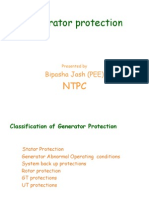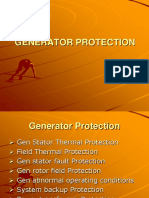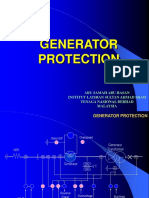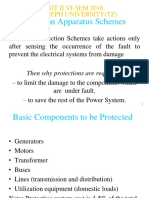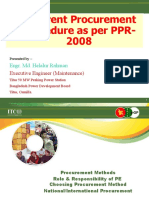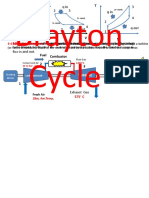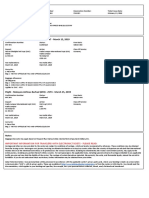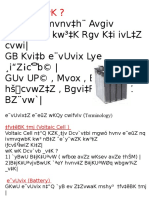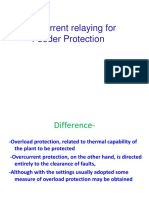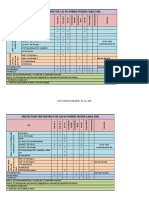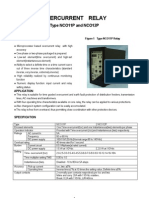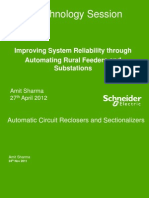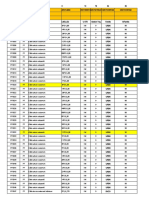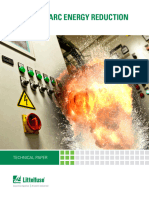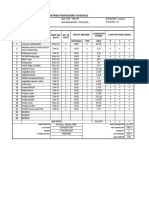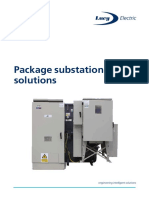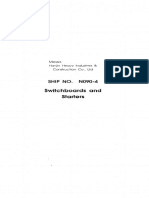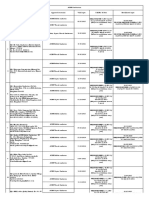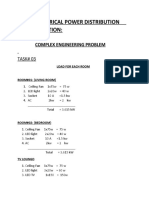GENERATOR PROTECTION
Completed by : Mohammad Ibnul Hossain Executive Engineer (Operation) Tongi 80(105) MW GT Power Station Bangladesh Power Development Board E-mail : ibnulhossain@yahoo.com
���Possible Faults
�Abnormal operating condition
overcurrent / overload unbalanced load over temperature over- and undervoltage over- and underexcitation over- and underfrequency over-fluxing asynchronous running out of step generator motoring failures in the machine control system (i.e. AVR or governor failure) failures in the machine cooling system
�In abnormal condition ,
those dont need immediate trip the unit generator
Or transformer but cant continue , at some stage we must trip-out the system.
�Different Power Plant Electrical Layout
�Damage to the stator core in case of earth-fault
The stator cant withstand with a small amount of ground current even With short period of time. Arrangement must be taken to limit the ground fault current not more than 10 amp.
�Stator winding Earthing Practice :
How it is done ? it is achieved by grounding Here we see different types of alternatives. Solidly grounded through a resistor typically in Europe
Grounding transformer , typically for U.S
�Allocation of Protection Function
32 Reverse Power
81 O/U Frequency
Turbine
87 Differential 59 over -voltages 24V/HZ over fluxing 49S stator Over load 51 over -current 64s Ground Fault stator Inter-turn
46 Negative Phase Sequence
40 Loss of excitation 71 pole slipping 64R Ground fault Rotor
Rotor
Stator
�No. 2 21 24 25 27
DESCRIPTION Time-delay relay Distance relay Over excitation / Volts per Hertz Synchronism-check relay Under voltage relay
27TN
30 32 37 40 46
Third-Harmonic Under voltage relay
Annunciator device Reverse power relay Undercurrent or underpower relay Field excitation relay Negative sequence overcurrent relay
�47
Negative sequence overvoltage relay
49
Thermal relay
50
instantaneous AC overcurrent relay
50DT
Split Phase Differential
50/27
inadvertent Energizing
50BF
Breaker Failure
51
AC Inverse Time Overcurrent relay
52
Circuit breaker
�Overvoltage relay 59
59D 59N
Third-Harmonic Voltage Differential Ratio
Single Phase Overvoltage Relay
60
63 64F 64B 64S 67 68 69
Voltage balance or loss of potential relay
Pressure device Field Ground relay Brush Lift-Off Detection 100% Stator Ground Protection by Low Frequency Injection AC directional overcurrent relay Power Swing Blocking Permissive relay
�74 76 78 79
Alarm relay DC overcurrent relay Out-of-step relay AC reclosing relay
81
81R 83 85 86 87 94
Frequency relay
Rate of Change Frequency relay Transfer device Carrier or pilot-wire relay Lock out relay Differential relay Auxiliary tripping relay
�Stator Short Circuit
Consequence of stator short circuit Insulation. windings and stator core can be damaged Large forces, caused by large fault currents. can
give damage to other components in the plant
Risk of explosion and fire
Mechanical stress on generator- and turbine
shafts
�Detection of stator short circuits Protection functions Generator differential protection Unit differential protection Directional negative sequence overcurrent protection Under impedance protection Phase overcurrent protection Voltage dependent phase overcurrent protection Under voltage protection Phase overcurrent protection of the unit transformer
�Phase to phase fault in the stator winding
Endangering condition Overcurrent Protected object Stator winding Consequences Heating Forces Smelted stator core
�GENERATOR AND UNIT TRANS FORMER UNIT SCHEME Diff.rel. 87 N OC 51 OC 50/51 Y Y Y Y OC 51 FL 60
OC(Idm/dir.)
Brk.flr. 50BF
OC 50/51
Therm. 49 o/a Diff 87O
U n i t X f o r .
Freq.rel. 81 Ac.Eneg 50
+ REX0061
Out of step
78
Udr.Imp.pro.
OVER EXCIT
24
UND.VOL.
51/67
100%GFP
Neg.Ph a. 50
Gen.st.dif
21
Rev. Pow.
27
OVER.VOL.
32
Under curr.
64S Neg.Ph Neg.Pha. a. 46 50 O.V 59N
59
FREQ.
87G Therm. 49
100%GFP
37
FIELD.EXCIT
81
40 50THD
100%GFP
+ REX0060
64S
�GENERATOR AND UNIT TRANS FORMER UNIT SCHEME Diff.rel. 87 N OC 51 OC 50/51 Y Y Y Y OC 51 FL 60
OC(Idm/dir.)
Brk.flr. 50BF
OC 50/51
Therm. 49 Diff(x-f) o/a Diff 87O
U n i t X f o r .
Freq.rel. 81 Ac.Eneg 50
+ REX0061
Out of step
78
Udr.Imp.pro. Distance
OVER EXCIT
24
UND.VOL.
51/67
100%GFP
Neg.Ph a. 50
Gen.st.dif
21
Rev. Pow.
27
OVER.VOL.
32
Under curr.
64S
Neg.Pha.
59
FREQ.
87G Therm. 49
100%GFP
37
FIELD.EXCIT
Neg.Ph a. 46 50 O.V 59N
81
40 50THD
100%GFP
+ REX0060
64S
�GENERATOR AND UNIT TRANS FORMER UNIT SCHEME Diff.rel. 87 N OC 51 OC 50/51 Y Y Y Y OC 51 FL 60
OC(Idm/dir.)
Brk.flr. 50BF
OC 50/51
Therm. 49 Diff(x-f) o/a Diff 87O
U n i t X f o r .
Freq.rel. 81 Ac.Eneg 50
+ REX0061
Out of step
78
Udr.Imp.pro. Distance
OVER EXCIT
24
UND.VOL.
51/67
100%GFP
Neg.Ph a. 50
Gen.st.dif
21
Rev. Pow.
27
OVER.VOL.
32
Under curr.
64S
Neg.Pha.
59
FREQ.
87G Therm. 49
100%GFP
37
FIELD.EXCIT
Neg.Ph a. 46 50 O.V 59N
81
40 50THD
100%GFP
+ REX0060
64S
�GENERATOR AND UNIT TRANS FORMER UNIT SCHEME Diff.rel. 87 N OC 51 OC 50/51 Y Y Y Y OC 51 FL 60
OC(Idm/dir.)
Brk.flr. 50BF
OC 50/51
Therm. 49 Diff(x-f) o/a Diff 87O
U n i t X f o r .
Freq.rel. 81 Ac.Eneg 50
+ REX0061
Out of step
78
Udr.Imp.pro. Distance
OVER EXCIT
24
UND.VOL.
51/67
100%GFP
Neg.Ph a. 50
Gen.st.dif
21
Rev. Pow.
27
OVER.VOL.
32
Under curr.
64S
Neg.Pha.
59
FREQ.
87G Therm. 49
100%GFP
37
FIELD.EXCIT
Neg.Ph a. 46 50 O.V 59N
81
40 50THD
100%GFP
+ REX0060
64S
�GENERATOR AND UNIT TRANS FORMER UNIT SCHEME Diff.rel. 87 N OC 51 OC 50/51 Y Y Y Y OC 51 FL 60
OC(Idm/dir.)
Brk.flr. 50BF
OC 50/51
Therm. 49 Diff(x-f) o/a Diff 87O 87O
U n i t X f o r .
Freq.rel. 81 Ac.Eneg 50
+ REX0061
Out of step
78
Distance Udr.Imp.pro.
OVER EXCIT
24
UND.VOL.
51/67
100%GFP
Neg.Ph a. 50
Gen.st.dif
21
Rev. Pow.
27
OVER.VOL.
32
Under curr.
64S
Neg.Pha.
59
FREQ.
87G Therm. 49
100%GFP
37
FIELD.EXCIT
Neg.Ph a. 46 50 O.V 59N
81
40 50THD
100%GFP
+ REX0060
64S
�Differential Protection
I1
CT1
I2
CT2
i2
i1 Diff. Relay TC i2
i2
i1 i1
Let us , Consider , X protected Equipment CT1 and CT2 same transformation ratio The current flow in the primary and secondary sides of power transformer are identical, assuming ideal transformer. The secondary current i1 and i2 are equal in magnitude and opposite in direction. So, the net current in the differential coil is zero at load condition (without fault), and the relay will not operate .
�Differential Protection
I1
CT1 i2 i1 i2
I2
CT2
Diff. Relay
i1 TC i1 i2
External Fault happens ,
Then , I1 and I2 increases as well as i1 and i2 increases But the phase angle of i1 and i2 will be the same , So , the net current in the TC or Operating Coil = 0 So, the relay will not operate
�Differential Protection
I1
CT1 i2 i1 i2
I2
CT2
Diff. Relay
i1 TC i1 i2
is another source to feed the fault , So I2 0 , I diff = i1 + i2 which is very high And trips the Differential Relay
�Biased differential relay
I1
CT1 Res. i1 Op i1
I2
CT2
i2
i1
Res.
i2
i2
Biased Diff. Relay
Large external fault cause false operation To make more stable Two Restraining ( Biasing ) coil And One Operating coil is introduced . What is the function of two Restraining ( Biasing ) Coils ? Restraining coils will oppose the operation of operating coil. The relay will operate only when the operating force > the restraining force
�Tripping Characteristics of Simple Differential Relay
�Tripping Characteristics of Biased Differential Relay with Two Stages (Two Slops )
�Connections of CTs for differential protection of generator. Percentage differential relaying of a star connected generator , for phase-phase faults.
�Percentage differential relay of a delta connected generator ,for phase-phase fault.
�Generator differential protection Operates then what happens ? Shall trip the followings : Turbine: close down active power Generator breaker: if available Field breaker Unit breaker: If no generator breaker
Fire protection
�Differential Protection can be used :
The layout of what we are talking about 87G the differential protection of gen87T- the differential protection of step-up transformer 870- both the generator and the step-up transformer.
��Phase to phase fault in the transformer winding Endangering condition Overcurrent Protected object Transformer windings Consequences Heating Forces Smelted transformer core
�Phase to phase fault in the transformer winding
Diff.rel. 87 N OC 51 OC 50/51 Y Y Y Y OC 51 FL 60
OC(Idm/dir.)
Brk.flr. 50BF
OC 50/51
Therm. 49 o/a Diff 87O
U n i t X f o r .
Freq.rel. 81 Ac.Eneg 50
+ REX0061
Out of step
78
Udr.Imp.pro.
OVER EXCIT
24
UND.VOL.
51/67
100%GFP
Neg.Ph a. 50
Gen.st.dif
21
Rev. Pow.
27
OVER.VOL.
32
Under curr.
64S
Neg.Pha.
59
FREQ.
87G Therm. 49
100%GFP
37
FIELD.EXCIT
Neg.Ph a. 46 50 O.V 59N
81
40 50THD
100%GFP
+ REX0060
64S
�Phase to phase fault in the transformer winding
Diff.rel. 87 N OC 51 OC 50/51 Y Y Y Y OC 51 FL 60
OC(Idm/dir.)
Brk.flr. 50BF
OC 50/51
Therm. 49 o/a Diff 87O
U n i t X f o r .
Freq.rel. 81 Ac.Eneg 50
+ REX0061
Out of step
78
Udr.Imp.pro.
OVER EXCIT
24
UND.VOL.
51/67
100%GFP
Neg.Ph a. 50
Gen.st.dif
21
Rev. Pow.
27
OVER.VOL.
32
Under curr.
64S
Neg.Pha.
59
FREQ.
87G Therm. 49
100%GFP
37
FIELD.EXCIT
Neg.Ph a. 46 50 O.V 59N
81
40 50THD
100%GFP
+ REX0060
64S
�Phase to phase fault in the transformer winding
Diff.rel. 87 N OC 51 OC 50/51 Y Y Y Y OC 51 FL 60
OC(Idm/dir.)
Brk.flr. 50BF
OC 50/51
Therm. 49 o/a Diff 87O
U n i t X f o r .
Freq.rel. 81 Ac.Eneg 50
+ REX0061
Out of step
78
Udr.Imp.pro.
OVER EXCIT
24
UND.VOL.
51/67
100%GFP
Neg.Ph a. 50
Gen.st.dif
21
Rev. Pow.
27
OVER.VOL.
32
Under curr.
64S
Neg.Pha.
59
FREQ.
87G Therm. 49
100%GFP
37
FIELD.EXCIT
Neg.Ph a. 46 50 O.V 59N
81
40 50THD
100%GFP
+ REX0060
64S
�Phase to phase fault in the transformer winding
Diff.rel. 87 N OC 51 OC 50/51 Y Y Y Y OC 51 FL 60
OC(Idm/dir.)
Brk.flr. 50BF
OC 50/51
Therm. 49 o/a Diff 87O
U n i t X f o r .
Freq.rel. 81 Ac.Eneg 50
+ REX0061
Out of step
78
Udr.Imp.pro.
OVER EXCIT
24
UND.VOL.
51/67
100%GFP
Neg.Ph a. 50
Gen.st.dif
21
Rev. Pow.
27
OVER.VOL.
32
Under curr.
64S
Neg.Pha.
59
FREQ.
87G Therm. 49
100%GFP
37
FIELD.EXCIT
Neg.Ph a. 46 50 O.V 59N
81
40 50THD
100%GFP
+ REX0060
64S
�fault impedance < load impedance So , the fault current > load current. If a short circuit occurs the circuit impedance therefore a fault is accompanied by large current Overcurrent relays sense fault currents and also over-load currents. Overcurrent protection is that protection in which the relay picks up when the magnitude of current exceeds the pickup level. The basic element in overcurrent protection is an overcurrent relay. The overcurrent relays are connected to the system, normally by means of CTs. Overcurrent relaying has following types : - High speed overcurrent protection. - Definite time overcurrent protection. - Inverse minimum time overcurrent protection. - Directional overcurrent protection (or above any type)
�Over-current protection includes the protection from overloads . Overloading of a machine or equipment means the machine is taking Current > rated current . Hence with overloading , there is an associated temperature rise . Overcurrent protection of overloads is generally provided by thermal relay. The permissible rise has limit based on insulation class and material problems.
�Over-current protection includes short-circuit protection. Short circuits can be phase faults earth faults winding faults. Short-circuit currents are generally several times (5 to 20) full load current. Fast fault clearance is always desirable on short-circuits When a machine is protected by differential protection, the over-current is provided in addition as a back-up and in some cases to protect the machine from sustained through fault.
�Several protective devices are used for over-current protection . These includes -Fuses -Miniature circuit-breakers, molded-case circuit-breakers. -Circuit-breakers fitted with overloaded coils or tripped by over-current relays. -Series connected trip coils operating switching devices. - Over-current relays in conjunction with current transformers.
�The primary requirements of over-current protection are : The protection should not operate starting currents permissible overcurrent Current surges. To achieve this The time delay is provided (in case of inverse relays) If time delay cannot be permitted high-set instantaneous relaying is used. - The protection should be co-ordinated with neighbouring over-current protections
�CHARACTERISTICS OF RELAY UNITS FOR OVER-CURRENT PROTECTION
There is a wide variety of relay-units. These are classified according to their type and characteristics. The major characteristic include : - Definite characteristic - Extremely Inverse -Inverse - Inverse characteristic - Very Inverse
�Inverse characteristic
t 1/I where I= Current in relay coil t = Relay lime K = Constant
Very Inverse characteristic t 1 / In where n = 2 to 8 , according to the requirements.
�. Connection Scheme with Three Over-current Relays
B
AUXILLARY SWITCH Relay Contact Overcurrent Relay
CB
IR IY
Trip Coil
IB
Relay Coil
�Connection Scheme with Three Over-current Relays with addition of a common time-delay relay and an auxiliary relay
AUXILLARY SWITCH Trip Coil R Y B AUXILLARY RELAY
DEFINITE TIME RELAY Relay Contact Overcurrent Relay
CB IR IY IB
Relay Coil
�Stator earth fault Damages on the stator iron Increased voltage on healthy phases Small fault currents Sensitivity requirements on fault clearance The fault resistance is normally low at stator earth fault
�RESTRICTED EARTH-FAULT PROTECTION BY DIFFERENTIAL SYSTEM
, Neutral is earthed through resistance to limit earth-fault currents. With resistance earthing, it is not possible to protect complete winding from earth-fault and the % of winding protected depends on the value of neutral earthing resistor and the relay setting Setting Criteria : The current rating of resistor, resistance value, relay setting, etc. should be selected carefully. Setting should be such that the protection does not operate for earth-faults on EHV side
�RESTRICTED EARTH-FAULT PROTECTION BY DIFFERENTIAL SYSTEM (Cont.) a
Setting Criteria (Cont.) :
Earth faults are not likely to occur near the neutral point due to less voltage w.r.t. earth. It is a usual practice to protect about 80 to 85% of generator winding against earth-faults. It is a usual practice to protect about 80 to 85% of generator winding against earth-faults. The remaining 20 to 5% winding from neutral side left unprotected by the differential protection. In additional to differential protection, a separate earth-fault protection is provided to take care of the complete winding against earth faults.
�RESTRICTED EARTH-FAULT PROTECTION BY DIFFERENTIAL SYSTEM (Cont.) a
During earth-fault the current, If flows through a part of the generator winding and neutral to ground circuit. The corresponding secondary current Is flows through the operating coil and restricted earth-fault coil of the differential protection. The setting of the restricted earth fault relay can be selected independent of the setting of the overcurrent relay.
�RESTRICTED EARTH-FAULT PROTECTION BY DIFFERENTIAL SYSTEM (Cont.)
Here, fault at point f , If fault current , Vaf Voltage If fault is nearer to neutral point Vaf is relatively less . Hence , If is reduced . Not practicable for too sensitive setting , because it will operate in through fault of small Magnitude for inaccurate CT and saturation of CT. Practice to provide 85% protection , the rest 15% is protected by another scheme. Discuss Next.
�100% STATOR EARTH-FAULT PROTECTION
Coupling Transformer Ground Circuit
Signal (12.5Hz) continuously injected Stator winding
No Fault Signal feed into stray capacitance . IN Fault Capacitance is by-passed and monitoring Current (of 12.5 Hz) is sensed by the measuring system.
�Earth Fault in Stator Winding
Endangering condition Overvoltage in two healthy phases Voltage in the star point Relatively small earth fault current
Protected object Stator winding Consequences Damage to the stator core Risk of second earth fault
�Stator Earth Fault Protection
Diff.rel. 87 N OC 51 OC 50/51 Y Y Y Y OC 51 FL 60
OC(Idm/dir.)
Brk.flr. 50BF
OC 50/51
Therm. 49 o/a Diff 87O
U n i t X f o r .
Freq.rel. 81 Ac.Eneg 50
+ REX0061
Out of step
78
Udr.Imp.pro.
OVER EXCIT
24
UND.VOL.
51/67
100%GFP
Neg.Ph a. 50
Gen.st.dif
21
Rev. Pow.
27
OVER.VOL.
32
Under curr.
64S
Neg.Pha.
59
FREQ.
87G Therm. 49
100%GFP
37
FIELD.EXCIT
Neg.Ph a. 46 50 O.V 59N
81
40 50THD
100%GFP
+ REX0060
64S
�Stator Earth Fault Protection
Diff.rel. 87 N OC 51 OC 50/51 Y Y Y Y OC 51 FL 60
OC(Idm/dir.)
Brk.flr. 50BF
OC 50/51
Therm. 49 o/a Diff 87O
U n i t X f o r .
Freq.rel. 81 Ac.Eneg 50
+ REX0061
Out of step
78
Udr.Imp.pro.
OVER EXCIT
24
UND.VOL.
51/67
100%GFP
Neg.Ph a. 50
Gen.st.dif
21
Rev. Pow.
27
OVER.VOL.
32
Under curr.
64S Neg.Ph a. 50 O.V 59N
59
FREQ.
87G Therm. 49
100%GFP
37
FIELD.EXCIT
81
40 50THD
100%GFP
+ REX0060
64S
�Stator Earth Fault Protection
Diff.rel. 87 N OC 51 OC 50/51 Y Y Y Y OC 51 FL 60
OC(Idm/dir.)
Brk.flr. 50BF
OC 50/51
Therm. 49 o/a Diff 87O
U n i t X f o r .
Freq.rel. 81 Ac.Eneg 50
+ REX0061
Out of step
78
Udr.Imp.pro.
OVER EXCIT
24
UND.VOL.
51/67
100%GFP
Neg.Ph a. 50
Gen.st.dif
21
Rev. Pow.
27
OVER.VOL.
32
Under curr.
64S
Neg.Pha.
59
FREQ.
87G Therm. 49
100%GFP
37
FIELD.EXCIT
Neg.Ph a. 46 50 O.V 59N
81
40 50THD
100%GFP
+ REX0060
64S
�Stator Earth Fault Close to star point
Diff.rel. 87 N OC 51 OC 50/51 Y Y Y Y OC 51 FL 60
OC(Idm/dir.)
Brk.flr. 50BF
OC 50/51
Therm. 49 o/a Diff 87O
U n i t X f o r .
Freq.rel. 81 Ac.Eneg 50
+ REX0061
Out of step
78
Udr.Imp.pro.
OVER EXCIT
24
UND.VOL.
51/67
100%GFP
Neg.Ph a. 50
Gen.st.dif
21
Rev. Pow.
27
OVER.VOL.
32
Under curr.
64S
Neg.Pha.
59
FREQ.
87G Therm. 49
100%GFP
37
FIELD.EXCIT
Neg.Ph a. 46 50 O.V 59N
81
40 50THD
100%GFP
+ REX0060
64S
�Stator Earth Fault Close to star point
Diff.rel. 87 N OC 51 OC 50/51 Y Y Y Y OC 51 FL 60
OC(Idm/dir.)
Brk.flr. 50BF
OC 50/51
Therm. 49 o/a Diff 87O
U n i t X f o r .
Freq.rel. 81 Ac.Eneg 50
+ REX0061
Out of step
78
Udr.Imp.pro.
OVER EXCIT
24
UND.VOL.
51/67
100%GFP
Neg.Ph a. 50
Gen.st.dif
21
Rev. Pow.
27
OVER.VOL.
32
Under curr.
64S
Neg.Pha.
59
FREQ.
87G Therm. 49
100%GFP
37
FIELD.EXCIT
Neg.Ph a. 46 50 O.V 59N
81
40 50THD
100%GFP
+ REX0060
64S
�Earth fault in transformer HV winding
Endangering condition Overcurrent Protected object Transformer windings
Consequences Heating Forces Smelted transformer core
�Earth fault in transformer HV winding
Diff.rel. 87 N OC 51 OC 50/51 Y Y Y Y OC 51 FL 60
OC(Idm/dir.)
Brk.flr. 50BF
OC 50/51
Therm. 49 o/a Diff 87O
U n i t X f o r .
Freq.rel. 81 Ac.Eneg 50
+ REX0061
Out of step
78
Udr.Imp.pro.
OVER EXCIT
24
UND.VOL.
51/67
100%GFP
Neg.Ph a. 50
Gen.st.dif
21
Rev. Pow.
27
OVER.VOL.
32
Under curr.
64S
Neg.Pha.
59
FREQ.
87G Therm. 49
100%GFP
37
FIELD.EXCIT
Neg.Ph a. 46 50 O.V 59N
81
40 50THD
100%GFP
+ REX0060
64S
�Earth fault in transformer HV winding
Diff.rel. 87 N OC 51 OC 50/51 Y Y Y Y OC 51 FL 60
OC(Idm/dir.)
Brk.flr. 50BF
OC 50/51
Therm. 49 o/a Diff 87O
U n i t X f o r .
Freq.rel. 81 Ac.Eneg 50
+ REX0061
Out of step
78
Udr.Imp.pro.
OVER EXCIT
24
UND.VOL.
51/67
100%GFP
Neg.Ph a. 50
Gen.st.dif
21
Rev. Pow.
27
OVER.VOL.
32
Under curr.
64S
Neg.Pha.
59
FREQ.
87G Therm. 49
100%GFP
37
FIELD.EXCIT
Neg.Ph a. 46 50 O.V 59N
81
40 50THD
100%GFP
+ REX0060
64S
�Earth fault in transformer HV winding
Diff.rel. 87 N OC 51 OC 50/51 Y Y Y Y OC 51 FL 60
OC(Idm/dir.)
Brk.flr. 50BF
OC 50/51
Therm. 49 o/a Diff 87O
U n i t X f o r .
Freq.rel. 81 Ac.Eneg 50
+ REX0061
Out of step
78
Udr.Imp.pro.
OVER EXCIT
24
UND.VOL.
51/67
100%GFP
Neg.Ph a. 50
Gen.st.dif
21
Rev. Pow.
27
OVER.VOL.
32
Under curr.
64S Neg.Ph a. 50 O.V 59N
59
FREQ.
87G Therm. 49
100%GFP
37
FIELD.EXCIT
81
40 50THD
100%GFP
+ REX0060
64S
�Stator Earth Fault Protection
Diff.rel. 87 N OC 51 OC 50/51 Y Y Y Y OC 51 FL 60
OC(Idm/dir.)
Brk.flr. 50BF
OC 50/51
Therm. 49 o/a Diff 87O
U n i t X f o r .
Freq.rel. 81 Ac.Eneg 50
+ REX0061
Out of step
78
Udr.Imp.pro.
OVER EXCIT
24
UND.VOL.
51/67
100%GFP
Neg.Ph a. 50
Gen.st.dif
21
Rev. Pow.
27
OVER.VOL.
32
Under curr.
64S
Neg.Pha.
59
FREQ.
87G Therm. 49
100%GFP
37
FIELD.EXCIT
Neg.Ph a. 46 50 O.V 59N
81
40 50THD
100%GFP
+ REX0060
64S
�Stator Earth fault in transformer HV winding
Diff.rel. 87 N OC 51 OC 50/51 Y Y Y Y OC 51 FL 60
OC(Idm/dir.)
Brk.flr. 50BF
OC 50/51
Therm. 49 o/a Diff 87O
U n i t X f o r .
Freq.rel. 81 Ac.Eneg 50
+ REX0061
Out of step
78
Udr.Imp.pro.
OVER EXCIT
24
UND.VOL.
51/67
100%GFP
Neg.Ph a. 50
Gen.st.dif
21
Rev. Pow.
27
OVER.VOL.
32
Under curr.
64S
Neg.Pha.
59
FREQ.
87G Therm. 49
100%GFP
37
FIELD.EXCIT
Neg.Ph a. 46 50 O.V 59N
81
40 50THD
100%GFP
+ REX0060
64S
�Earth fault in transformer HV winding
Diff.rel. 87 N OC 51 OC 50/51 Y Y Y Y OC 51 FL 60
OC(Idm/dir.)
Brk.flr. 50BF
OC 50/51
Therm. 49 o/a Diff 87O
U n i t X f o r .
Freq.rel. 81 Ac.Eneg 50
+ REX0061
Out of step
78
Udr.Imp.pro.
OVER EXCIT
24
UND.VOL.
51/67
100%GFP
Neg.Ph a. 50
Gen.st.dif
21
Rev. Pow.
27
OVER.VOL.
32
Under curr.
64S
Neg.Pha.
59
FREQ.
87G Therm. 49
100%GFP
37
FIELD.EXCIT
Neg.Ph a. 46 50 O.V 59N
81
40 50THD
100%GFP
+ REX0060
64S
�Earth fault in transformer LV winding
Endangering condition Overvoltage in two healthy phases Voltage in the star point Relatively small earth fault current
Protected object Transformer winding Consequences Small possibility to damage transformer core Risk of second earth fault
�Earth-Fault in the LV Winding
Diff.rel. 87 N OC 51 OC 50/51 Y Y Y Y OC 51 FL 60
OC(Idm/dir.)
Brk.flr. 50BF
OC 50/51
Therm. 49 o/a Diff 87O
U n i t X f o r .
Freq.rel. 81 Ac.Eneg 50
+ REX0061
Out of step
78
Udr.Imp.pro.
OVER EXCIT
24
UND.VOL.
51/67
100%GFP
Neg.Ph a. 50
Gen.st.dif
21
Rev. Pow.
27
OVER.VOL.
32
Under curr.
64S Neg.Ph a. 50 O.V 59N
59
FREQ.
87G Therm. 49
100%GFP
37
FIELD.EXCIT
81
40 50THD
100%GFP
+ REX0060
64S
�Earth-Fault in the LV Winding
Diff.rel. 87 N OC 51 OC 50/51 Y Y Y Y OC 51 FL 60
OC(Idm/dir.)
Brk.flr. 50BF
OC 50/51
Therm. 49 o/a Diff 87O
U n i t X f o r .
Freq.rel. 81 Ac.Eneg 50
+ REX0061
Out of step
78
Udr.Imp.pro.
OVER EXCIT
24
UND.VOL.
51/67
100%GFP
Neg.Ph a. 50
Gen.st.dif
21
Rev. Pow.
27
OVER.VOL.
32
Under curr.
64S Neg.Ph a. 50 O.V 59N
59
FREQ.
87G Therm. 49
100%GFP
37
FIELD.EXCIT
81
40 50THD
100%GFP
+ REX0060
64S
�Earth-Fault in the LV Winding
Diff.rel. 87 N OC 51 OC 50/51 Y Y Y Y OC 51 FL 60
OC(Idm/dir.)
Brk.flr. 50BF
OC 50/51
Therm. 49 o/a Diff 87O
U n i t X f o r .
Freq.rel. 81 Ac.Eneg 50
+ REX0061
Out of step
78
Udr.Imp.pro.
OVER EXCIT
24
UND.VOL.
51/67
100%GFP
Neg.Ph a. 50
Gen.st.dif
21
Rev. Pow.
27
OVER.VOL.
32
Under curr.
64S Neg.Ph a. 50 O.V 59N
59
FREQ.
87G Therm. 49
100%GFP
37
FIELD.EXCIT
81
40 50THD
100%GFP
+ REX0060
64S
�Turn to turn turn fault in the stator winding :
�Earth-Fault in the LV Winding
Diff.rel. 87 N OC 51 OC 50/51 Y Y Y Y OV 59N FL 60
OC(Idm/dir.)
Brk.flr. 50BF
OC 50/51
Therm. 49 o/a Diff 87O
U n i t X f o r .
Freq.rel. 81 Ac.Eneg 50
+ REX0061
Out of step
78
Udr.Imp.pro.
OVER EXCIT
24
UND.VOL.
51/67
100%GFP
Neg.Ph a. 50
Gen.st.dif
21
Rev. Pow.
27
OVER.VOL.
32
Under curr.
64S Neg.Ph a. 50 O.V 59N
59
FREQ.
87G Therm. 49
100%GFP
37
FIELD.EXCIT
81
40 50THD
100%GFP
+ REX0060
64S
�Earth-Fault in the LV Winding
Diff.rel. 87 N OC 51 OC 50/51 Y Y Y Y OV 59N FL 60
OC(Idm/dir.)
Brk.flr. 50BF
OC 50/51
Therm. 49 o/a Diff 87O
U n i t X f o r .
51N detected the fault when It developes
Freq.rel. 81 Ac.Eneg 50
+ REX0061
Out of step
78
Udr.Imp.pro.
OVER EXCIT
24
UND.VOL.
51/67
100%GFP
Neg.Ph a. 50
Gen.st.dif
21
Rev. Pow.
27
OVER.VOL.
32
Under curr.
64S Neg.Ph a. 50 O.V 59N
59
FREQ.
87G Therm. 49
100%GFP
37
FIELD.EXCIT
81
40 50THD
100%GFP
+ REX0060
64S
�Earth-Fault in the LV Winding
Diff.rel. 87 N OC 51 OC 50/51 Y Y Y Y OV 59N FL 60
OC(Idm/dir.)
Brk.flr. 50BF
OC 50/51
Therm. 49 o/a Diff 87O
U n i t X f o r .
51N detected the fault when It developes
Freq.rel. 81 Ac.Eneg 50
+ REX0061
Out of step
78
Udr.Imp.pro.
OVER EXCIT
24
UND.VOL.
51/67
100%GFP
Neg.Ph a. 50
Gen.st.dif
21
Rev. Pow.
27
OVER.VOL.
32
Under curr.
64S Neg.Ph a. 50 O.V 59N
59
FREQ.
87G Therm. 49
100%GFP
37
FIELD.EXCIT
81
40 50THD
100%GFP
+ REX0060
64S
�Rotor Earth Fault : The field circuit of the generator is normally isolated from earth With a single earth fault in the rotor circuit it is possible to have continuous operation without generator damages There is however a risk of a second rotor earth fault. In such a case there will be large current and risk of severe damages. The requirement of fast fault clearance is moderate
��Earth-Fault in Rotor Winding : Endangering condition None Protected object Rotor winding
Consequences
Risk of evolving into double earth fault
�Earth-Fault in the Rotor
Diff.rel. 87 N OC 51 OC 50/51 Y Y Y Y OV 59N FL 60
OC(Idm/dir.)
Brk.flr. 50BF
OC 50/51
Therm. 49 o/a Diff 87O
U n i t X f o r .
Freq.rel. 81 Ac.Eneg 50
+ REX0061
Out of step
78
Udr.Imp.pro.
OVER EXCIT
24
UND.VOL.
51/67
100%GFP
Neg.Ph a. 50
Gen.st.dif
21
Rev. Pow.
27
OVER.VOL.
32
Under curr.
64S Neg.Ph a. 50 O.V 59N
59
FREQ.
87G Therm. 49
100%GFP
37
FIELD.EXCIT
81
40 50THD
100%GFP
+ REX0060
64S
�Earth-Fault in the Rotor
Diff.rel. 87 N OC 51 OC 50/51 Y Y Y Y OV 59N FL 60
OC(Idm/dir.)
Brk.flr. 50BF
OC 50/51
Therm. 49 o/a Diff 87O
U n i t X f o r .
Freq.rel. 81 Ac.Eneg 50
+ REX0061
Out of step
78
Udr.Imp.pro.
OVER EXCIT
24
UND.VOL.
51/67
100%GFP
Neg.Ph a. 50
Gen.st.dif
21
Rev. Pow.
27
OVER.VOL.
32
Under curr.
64S Neg.Ph a. 50 O.V 59N
59
FREQ.
87G Therm. 49
100%GFP
37
FIELD.EXCIT
81
40 50THD
100%GFP
+ REX0060
64S
��Loss of/Under excitation Endangering condition
Stator reactive current component
Protected object Rotor and stator winding Consequences Thermal damage of rotor and stator end regions Asynchronous machine operation Voltage and current variations
�Earth-Fault in the Rotor
Diff.rel. 87 N OC 51 OC 50/51 Y Y Y Y OV 59N FL 60
OC(Idm/dir.)
Brk.flr. 50BF
OC 50/51
Therm. 49 o/a Diff 87O
U n i t X f o r .
Freq.rel. 81 Ac.Eneg 50
+ REX0061
Out of step
78
Udr.Imp.pro.
OVER EXCIT
24
UND.VOL.
51/67
100%GFP
Neg.Ph a. 50
Gen.st.dif
21
Rev. Pow.
27
OVER.VOL.
32
Under curr.
64S Neg.Ph a. 50 O.V 59N
59
FREQ.
87G Therm. 49
100%GFP
37
FIELD.EXCIT
81
40 50THD
100%GFP
+ REX0060
64S
�Earth-Fault in the Rotor
Diff.rel. 87 N OC 51 OC 50/51 Y Y Y Y OV 59N FL 60
OC(Idm/dir.)
Brk.flr. 50BF
OC 50/51
Therm. 49 o/a Diff 87O
U n i t X f o r .
Freq.rel. 81 Ac.Eneg 50
+ REX0061
Out of step
78
Udr.Imp.pro.
OVER EXCIT
24
UND.VOL.
51/67
100%GFP
Neg.Ph a. 50
Gen.st.dif
21
Rev. Pow.
27
OVER.VOL.
32
Under curr.
64S Neg.Ph a. 50 O.V 59N
59
FREQ.
87G Therm. 49
100%GFP
37
FIELD.EXCIT
81
40 50THD
100%GFP
+ REX0060
64S
�Generator motoring protection Generator shall produce active power (i.e. P>0) When it starts to receive the active power it acts as a motor (i.e. P<0) Not dangerous operating condition for machine but it
may be dangerous for the turbine
�Causes loss of prime-mover low water flow (hydro) load variations I problems Effects steam units overheating of turbine and turbine blade hydro units cavitations of the blades
�Reverse Power Protection Endangering condition Motor operation Protected object Turbine
Consequences Excessive heating of turbine blades (steam units) Mechanical damages to thrust bearing (Francis turbines) Explosion risk for diesel units
�Reverse Power Protection
Diff.rel. 87 N OC 51 OC 50/51 Y Y Y Y OV 59N FL 60
OC(Idm/dir.)
Brk.flr. 50BF
OC 50/51
Therm. 49 o/a Diff 87O
U n i t X f o r .
Freq.rel. 81 Ac.Eneg 50
+ REX0061
Out of step
78
Udr.Imp.pro.
OVER EXCIT
24
UND.VOL.
51/67
100%GFP
Neg.Ph a. 50
Gen.st.dif
21
Rev. Pow.
27
OVER.VOL.
32
Under curr.
64S Neg.Ph a. 50 O.V 59N
59
FREQ.
87G Therm. 49
100%GFP
37
FIELD.EXCIT
81
40 50THD
100%GFP
+ REX0060
64S
�Reverse Power Protection
Diff.rel. 87 N OC 51 OC 50/51 Y Y Y Y OV 59N FL 60
OC(Idm/dir.)
Brk.flr. 50BF
OC 50/51
Therm. 49 o/a Diff 87O
U n i t X f o r .
Freq.rel. 81 Ac.Eneg 50
+ REX0061
Out of step
78
Udr.Imp.pro.
OVER EXCIT
24
UND.VOL.
51/67
100%GFP
Neg.Ph a. 50
Gen.st.dif
21
Rev. Pow.
27
OVER.VOL.
32
Under curr.
64S Neg.Ph a. 50 O.V 59N
59
FREQ.
87G Therm. 49
100%GFP
37
FIELD.EXCIT
81
40 50THD
100%GFP
+ REX0060
64S
�Negative sequence overcurrent
From asymmetric currents, a negative sequence current component 12, is filtered out. Negative sequence stator currents rotate in a opposite direction from the rotor and consequently induce a 100Hz current component into the rotor. As a consequence rotor ends can over-heat. k is the indicator of how long (Sec.) a generator can withstand one/unit Neg.seq.Cur.
�Negative phase sequence (46) Causes unbalanced loads untransposed transmission circuits unbalanced system faults series faults CB pole discrepancy open circuits Features Characteristic adjustable to I22t = K K determines the right tripping time , which is provided by the manufacturer (one/unit Neg.seq.Cur)
�Stator Earth Fault Protection
Diff.rel. 87 N OC 51 OC 50/51 Y Y Y Y OC 51 FL 60
OC(Idm/dir.)
Brk.flr. 50BF
OC 50/51
Therm. 49 o/a Diff 87O
U n i t X f o r .
Freq.rel. 81 Ac.Eneg 50
+ REX0061
Out of step
78
Udr.Imp.pro.
OVER EXCIT
24
UND.VOL.
51/67
100%GFP
Neg.Ph a. 50
Gen.st.dif
21
Rev. Pow.
27
OVER.VOL.
32
Under curr.
64S
Neg.Pha.
59
FREQ.
87G Therm. 49
100%GFP
37
FIELD.EXCIT
Neg.Ph a. 46 50 O.V 59N
81
40 50THD
100%GFP
+ REX0060
64S
�Stator Earth Fault Protection
Diff.rel. 87 N OC 51 OC 50/51 Y Y Y Y OC 51 FL 60
OC(Idm/dir.)
Brk.flr. 50BF
OC 50/51
Therm. 49 o/a Diff 87O
U n i t X f o r .
Freq.rel. 81 Ac.Eneg 50
+ REX0061
Out of step
78
Udr.Imp.pro.
OVER EXCIT
24
UND.VOL.
51/67
100%GFP
Neg.Ph a. 50
Gen.st.dif
21
Rev. Pow.
27
OVER.VOL.
32
Under curr.
64S
Neg.Pha.
59
FREQ.
87G Therm. 49
100%GFP
37
FIELD.EXCIT
Neg.Ph a. 46 50 O.V 59N
81
40 50THD
100%GFP
+ REX0060
64S
�Broken stator winding Endangering condition Unsymmetrical currents Protected object Stator windings Rotor Consequences Rotor overheating Vibrations
�Broken transformer winding Endangering condition Unsymmetrical currents Protected object Stator windings Rotor Consequences Rotor overheating Vibrations
�Stator Earth Fault Protection
Diff.rel. 87 N OC 51 OC 50/51 Y Y Y Y OC 51 FL 60
OC(Idm/dir.)
Brk.flr. 50BF
OC 50/51
Therm. 49 o/a Diff 87O
U n i t X f o r .
Freq.rel. 81 Ac.Eneg 50
+ REX0061
Out of step
78
Udr.Imp.pro.
OVER EXCIT
24
UND.VOL.
51/67
100%GFP
Neg.Ph a. 50
Gen.st.dif
21
Rev. Pow.
27
OVER.VOL.
32
Under curr.
64S
Neg.Pha.
59
FREQ.
87G Therm. 49
100%GFP
37
FIELD.EXCIT
Neg.Ph a. 46 50 O.V 59N
81
40 50THD
100%GFP
+ REX0060
64S
�Pole slip / out of step protection
Asynchronous running of a synchronous machine with the rest of the system but with excitation intact
Big mechanical impact on turbine and shaft
Pole Slip typically caused by: Long fault clearance time (especially close by 3Ph faults are critical) Inadvertent tripping of a transmission line (increase of transmission impedance between generator and load) Loss of large generator unit
�Pole slip / out of step protection
Endangering condition High stator current Possible system blackout
Protected object Rotor shaft and stator winding Consequences Mechanical damages to shaft Asynchronous machine operation (with field intact) Voltage and current variations
�Pole slip / out of step protection
Diff.rel. 87 N OC 51 OC 50/51 Y Y Y Y OC 51 FL 60
OC(Idm/dir.)
Brk.flr. 50BF
OC 50/51
Therm. 49 o/a Diff 87O
U n i t X f o r .
Freq.rel. 81 Ac.Eneg 50
+ REX0061
Out of step
78
Udr.Imp.pro.
OVER EXCIT
24
UND.VOL.
21 O.C 50
Gen.st.dif
Rev. Pow.
51/67
27
OVER.VOL.
100%GFP
32
Under curr.
64S
Neg.Pha.
59
FREQ.
87G Therm. 49
100%GFP
37
FIELD.EXCIT
Neg.Ph a. 46 50 O.V 59N
81
40 50THD
100%GFP
+ REX0060
64S
�Pole slip / out of step protection
Diff.rel. 87 N OC 51 OC 50/51 Y Y Y Y OC 51 FL 60
OC(Idm/dir.)
Brk.flr. 50BF
OC 50/51
Therm. 49 o/a Diff 87O
U n i t X f o r .
Freq.rel. 81 Ac.Eneg 50
+ REX0061
Out of step
78
Udr.Imp.pro.
OVER EXCIT
24
UND.VOL.
51/67
100%GFP
Neg.Ph a. 50
Gen.st.dif
21
Rev. Pow.
27
OVER.VOL.
32
Under curr.
64S
Neg.Pha.
59
FREQ.
87G Therm. 49
100%GFP
37
FIELD.EXCIT
Neg.Ph a. 46 50 O.V 59N
81
40 50THD
100%GFP
+ REX0060
64S
�Low frequency Endangering condition Under-frequency Protected object Transformer Steam turbine Consequences Over-excitation Steam turbine vibrations
�Low frequency
Diff.rel. 87 N OC 51 OC 50/51 Y Y Y Y OC 51 FL 60
OC(Idm/dir.)
Brk.flr. 50BF
OC 50/51
Therm. 49 o/a Diff 87O
U n i t X f o r .
Freq.rel. 81 Ac.Eneg 50
+ REX0061
Out of step
78
Udr.Imp.pro.
OVER EXCIT
24
UND.VOL.
21 O.C 50
Gen.st.dif
Rev. Pow.
51/67
27
OVER.VOL.
100%GFP
32
Under curr.
64S
Neg.Pha.
59
FREQ.
87G Therm. 49
100%GFP
37
FIELD.EXCIT
Neg.Ph a. 46 50 O.V 59N
81
40 50THD
100%GFP
+ REX0060
64S
�Low frequency
Diff.rel. 87 N OC 51 OC 50/51 Y Y Y Y OC 51 FL 60
OC(Idm/dir.)
Brk.flr. 50BF
OC 50/51
Therm. 49 o/a Diff 87O
U n i t X f o r .
Freq.rel. 81 Ac.Eneg 50
+ REX0061
Out of step
78
Udr.Imp.pro.
OVER EXCIT
24
UND.VOL.
21 O.C 50
Gen.st.dif
Rev. Pow.
51/67
27
OVER.VOL.
100%GFP
32
Under curr.
64S
Neg.Pha.
59
FREQ.
87G Therm. 49
100%GFP
37
FIELD.EXCIT
Neg.Ph a. 46 50 O.V 59N
81
40 50THD
100%GFP
+ REX0060
64S
�High Frequency Endangering condition Over-frequency
Protected object Turbine Rotor
Consequences Mechanical stresses Turbine vibrations
�Low frequency
Diff.rel. 87 N OC 51 OC 50/51 Y Y Y Y OC 51 FL 60
OC(Idm/dir.)
Brk.flr. 50BF
OC 50/51
Therm. 49 o/a Diff 87O
U n i t X f o r .
Freq.rel. 81 Ac.Eneg 50
+ REX0061
Out of step
78
Udr.Imp.pro.
OVER EXCIT
24
UND.VOL.
21 O.C 50
Gen.st.dif
Rev. Pow.
51/67
27
OVER.VOL.
100%GFP
32
Under curr.
64S
Neg.Pha.
59
FREQ.
87G Therm. 49
100%GFP
37
FIELD.EXCIT
Neg.Ph a. 46 50 O.V 59N
81
40 50THD
100%GFP
+ REX0060
64S
�Low frequency
Diff.rel. 87 N OC 51 OC 50/51 Y Y Y Y OC 51 FL 60
OC(Idm/dir.)
Brk.flr. 50BF
OC 50/51
Therm. 49 o/a Diff 87O
U n i t X f o r .
Freq.rel. 81 Ac.Eneg 50
+ REX0061
Out of step
78
Udr.Imp.pro.
OVER EXCIT
24
UND.VOL.
21 O.C 50
Gen.st.dif
Rev. Pow.
51/67
27
OVER.VOL.
100%GFP
32
Under curr.
64S
Neg.Pha.
59
FREQ.
87G Therm. 49
100%GFP
37
FIELD.EXCIT
Neg.Ph a. 46 50 O.V 59N
81
40 50THD
100%GFP
+ REX0060
64S
��Over Voltage Protection:
Endangering condition Over-voltage Improper voltage regulation Protected object Electrical circuits Consequences Increased risk for earth-faults Over-excitation
�Over Voltage Protection:
Diff.rel. 87 N OC 51 OC 50/51 Y Y Y Y OC 51 FL 60
OC(Idm/dir.)
Brk.flr. 50BF
OC 50/51
Therm. 49 o/a Diff 87O
U n i t X f o r .
Freq.rel. 81 Ac.Eneg 50
+ REX0061
Out of step
78
Udr.Imp.pro.
OVER EXCIT
24
UND.VOL.
21 O.C 50
Gen.st.dif
Rev. Pow.
51/67
27
OVER.VOL.
100%GFP
32
Under curr.
64S
Neg.Pha.
59
FREQ.
87G Therm. 49
100%GFP
37
FIELD.EXCIT
Neg.Ph a. 46 50 O.V 59N
81
40 50THD
100%GFP
+ REX0060
64S
�Over Voltage Protection:
Diff.rel. 87 N OC 51 OC 50/51 Y Y Y Y OC 51 FL 60
OC(Idm/dir.)
Brk.flr. 50BF
OC 50/51
Therm. 49 o/a Diff 87O
U n i t X f o r .
Freq.rel. 81 Ac.Eneg 50
+ REX0061
Out of step
78
Udr.Imp.pro.
OVER EXCIT
24
UND.VOL.
21 O.C 50
Gen.st.dif
Rev. Pow.
51/67
27
OVER.VOL.
100%GFP
32
Under curr.
64S
Neg.Pha.
59
FREQ.
87G Therm. 49
100%GFP
37
FIELD.EXCIT
Neg.Ph a. 46 50 O.V 59N
81
40 50THD
100%GFP
+ REX0060
64S
�Over-fluxing Over fluxing protection protects generator and transformer magnetic core against overheating Specially critical during start-up and shut-down Wide frequency operation of the relay important for generator protection
��Over Voltage Protection:
Diff.rel. 87 N OC 51 OC 50/51 Y Y Y Y OC 51 FL 60
OC(Idm/dir.)
Brk.flr. 50BF
OC 50/51
Therm. 49 o/a Diff 87O
U n i t X f o r .
Freq.rel. 81 Ac.Eneg 50
+ REX0061
Out of step
78
Udr.Imp.pro.
OVER EXCIT
24
UND.VOL.
21 O.C 50
Gen.st.dif
Rev. Pow.
51/67
27
OVER.VOL.
100%GFP
32
Under curr.
64S
Neg.Pha.
59
FREQ.
87G Therm. 49
100%GFP
37
FIELD.EXCIT
Neg.Ph a. 46 50 O.V 59N
81
40 50THD
100%GFP
+ REX0060
64S
��Stator Thermal Overload
Diff.rel. 87 N OC 51 OC 50/51 Y Y Y Y OC 51 FL 60
OC(Idm/dir.)
Brk.flr. 50BF
OC 50/51
Therm. 49 o/a Diff 87O
U n i t X f o r .
Freq.rel. 81 Ac.Eneg 50
+ REX0061
Out of step
78
Udr.Imp.pro.
OVER EXCIT
24
UND.VOL.
21 O.C 50
Gen.st.dif
Rev. Pow.
51/67
27
OVER.VOL.
100%GFP
32
Under curr.
64S
Neg.Pha.
59
FREQ.
87G Therm. 49
100%GFP
37
FIELD.EXCIT
Neg.Ph a. 46 50 O.V 59N
81
40 50THD
100%GFP
+ REX0060
64S
�Stator Thermal Overload
Diff.rel. 87 N OC 51 OC 50/51 Y Y Y Y OC 51 FL 60
OC(Idm/dir.)
Brk.flr. 50BF
OC 50/51
Therm. 49 o/a Diff 87O
U n i t X f o r .
Freq.rel. 81 Ac.Eneg 50
+ REX0061
Out of step
78
Udr.Imp.pro.
OVER EXCIT
24
UND.VOL.
21 O.C 50
Gen.st.dif
Rev. Pow.
51/67
27
OVER.VOL.
100%GFP
32
Under curr.
64S
Neg.Pha.
59
FREQ.
87G Therm. 49
100%GFP
37
FIELD.EXCIT
Neg.Ph a. 46 50 O.V 59N
81
40 50THD
100%GFP
+ REX0060
64S
���Stator Thermal Overload
Diff.rel. 87 N OC 51 OC 50/51 Y Y Y Y OC 51 FL 60
OC(Idm/dir.)
Brk.flr. 50BF
OC 50/51
Therm. 49 o/a Diff 87O
U n i t X f o r .
Freq.rel. 81 Ac.Eneg 50
+ REX0061
Out of step
78
Udr.Imp.pro.
OVER EXCIT
24
UND.VOL.
21 O.C 50
Gen.st.dif
Rev. Pow.
51/67
27
OVER.VOL.
100%GFP
32
Under curr.
64S
Neg.Pha.
59
FREQ.
87G Therm. 49
100%GFP
37
FIELD.EXCIT
Neg.Ph a. 46 50 O.V 59N
81
40 50THD
100%GFP
+ REX0060
64S
�Stator Thermal Overload
Diff.rel. 87 N OC 51 OC 50/51 Y Y Y Y OC 51 FL 60
OC(Idm/dir.)
Brk.flr. 50BF
OC 50/51
Therm. 49 o/a Diff 87O
U n i t X f o r .
Freq.rel. 81 Ac.Eneg 50
+ REX0061
Out of step
78
Udr.Imp.pro.
OVER EXCIT
24
UND.VOL.
21 O.C 50
Gen.st.dif
Rev. Pow.
51/67
27
OVER.VOL.
100%GFP
32
Under curr.
64S
Neg.Pha.
59
FREQ.
87G Therm. 49
100%GFP
37
FIELD.EXCIT
Neg.Ph a. 46 50 O.V 59N
81
40 50THD
100%GFP
+ REX0060
64S
�Breaker Failure (50BF)
�Stator Thermal Overload
Diff.rel. 87 N OC 51 OC 50/51 Y Y Y Y OC 51 FL 60
OC(Idm/dir.)
Brk.flr. 50BF
OC 50/51
Therm. 49 o/a Diff 87O
U n i t X f o r .
Freq.rel. 81 Ac.Eneg 50
+ REX0061
Out of step
78
Udr.Imp.pro.
OVER EXCIT
24
UND.VOL.
21 BF 50
Gen.st.dif
Rev. Pow.
51/67
27
OVER.VOL.
100%GFP
32
Under curr.
64S
Neg.Pha.
59
FREQ.
87G Therm. 49
100%GFP
37
FIELD.EXCIT
Neg.Ph a. 46 50 O.V 59N
81
40 50THD
100%GFP
+ REX0060
64S
�Stator Thermal Overload
Diff.rel. 87 N OC 51 OC 50/51 Y Y Y Y OC 51 FL 60
OC(Idm/dir.)
Brk.flr. 50BF
OC 50/51
Therm. 49 o/a Diff 87O
U n i t X f o r .
Freq.rel. 81 Ac.Eneg 50
+ REX0061
Out of step
78
Udr.Imp.pro.
OVER EXCIT
24
UND.VOL.
21 BF 50
Gen.st.dif
Rev. Pow.
51/67
27
OVER.VOL.
100%GFP
32
Under curr.
64S
Neg.Pha.
59
FREQ.
87G Therm. 49
100%GFP
37
FIELD.EXCIT
Neg.Ph a. 46 50 O.V 59N
81
40 50THD
100%GFP
+ REX0060
64S
�THANK YOU



















